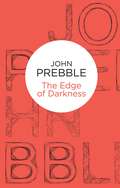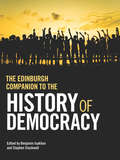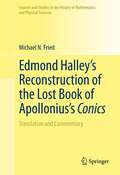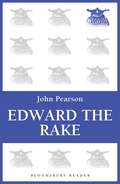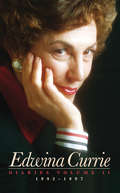- Table View
- List View
Edexcel A2 History Unit 3 E2: A World Divided - Superpower Relations, 1944-90 (PDF) (Student Support Materials For History Ser.)
by Andrew Mitchell Angela Leonard Robin Bunce Laura Williams Laura GallagherEnable students to succeed in their exam with Superpower Relations. This study aid contains the key information that students need for Edexcel History A2 Unit 3 Option E2, clearly laid out with Examiners' and Essential notes. Also included are graded essays with full comments from experienced examiners on how to secure higher grades.
Edexcel AS History: The Changing Position of Women (PDF)
by Bunce, Robin E. R.Unlock your full potential with this revision guide which focuses on the key content and skills you need to know for Edexcel AS History: Britain, c.1860-1930: The Changing Position of Women. Written by experienced teachers, this series closely combines the content of Edexcel AS History: Britain, c.1860-1930: The Changing Position of Women with revision activities and advice on exam technique. Each section has a model answer with exam tips for you to analyse and better understand what is required in the exam. - Makes revision manageable by condensing topics into easy-to-revise chunks- Encourages active revision by closely combining content with a variety of different activities- Helps improve exam technique through tailor-made activities and plenty of guidance on how to answer questions- Includes access to quick quizzes at www.hodderplus.co.uk/myrevisionnotes Contents Section 1: The changing personal status of women Section 2: Women's changing role within the political system, 1870-1920 Section 3: Attitudes of politicians, parliament and the public to the suffrage question Section 4: Changing educational and employment opportunities for women, 1870-1930
Edge of Darkness
by John PrebbleThe final offensives of the Second World War – Arnhem, the Rhine crossing and the invasion of Germany – provide war-shattered settings for John Prebble’s novel, The Edge of Darkness. In this, the most intimately experience of all his books, he records the feelings and reactions (seldom heroic) of five very different members of a front-line searchlight troop. But victory and vengeance breed anti-climax. In the rubble of post-war Hamburg, with its currency of cigarettes and its sinister black market, and in the brief, flickering affair between Ted Jones and a tragic German widow John Prebble faithfully portrays Germany in defeat. Like Culloden, his famous account of the Forty-five, The Edge of Darkness is neither cheerful nor glorious. It is a grim but just epitaph on war.
The Edinburgh Companion to the History of Democracy: From Pre-history to Future Possibilities
by Benjamin Isakhan Stephen StockwellRe-examines the history of democracy, broadening the traditional view with previously unexplored examples This substantial reference work critically re-examines the history of democracy, from ancient history to possible directions it may take in the future. 44 chapters explore the origins of democracy and explore new – and sometimes surprising – examples from around the world. Each of the 9 parts introduces the period, followed by 3 to 7 case studies. The first book to study lesser-known histories of democracy alongside familiar examples Includes historical accounts from leading scholars that document the development of democratic practices in their area or epoch of interest Contributors include Jack Goody, John Keane, Larbi Sadiki, James Anderson, John Fisher and Seymour Drescher Examples include ancient India, medieval Venetia, Native America, Iraqis, ancient Athens, Women's Suffrage and the Anti-Apartheid movement
Edmond Halley’s Reconstruction of the Lost Book of Apollonius’s Conics: Translation and Commentary (Sources and Studies in the History of Mathematics and Physical Sciences)
by Michael N. FriedApollonius’s Conics was one of the greatest works of advanced mathematics in antiquity. The work comprised eight books, of which four have come down to us in their original Greek and three in Arabic. By the time the Arabic translations were produced, the eighth book had already been lost. In 1710, Edmond Halley, then Savilian Professor of Geometry at Oxford, produced an edition of the Greek text of the Conics of Books I-IV, a translation into Latin from the Arabic versions of Books V-VII, and a reconstruction of Book VIII. The present work provides the first complete English translation of Halley’s reconstruction of Book VIII with supplementary notes on the text. It also contains 1) an introduction discussing aspects of Apollonius’s Conics 2) an investigation of Edmond Halley's understanding of the nature of his venture into ancient mathematics, and 3) an appendices giving a brief account of Apollonius’s approach to conic sections and his mathematical techniques.This book will be of interest to students and researchers interested in the history of ancient Greek mathematics and mathematics in the early modern period.
Edmund Campion: Jesuit And Martyr (Forsyte chronicles)
by Evelyn WaughIn 1581 Edmund Campion, a Jesuit priest working underground in Protestant England, was found guilty of treason and hanged, drawn and quartered at Tyburn. Years later he would be beatified. Evelyn Waugh's compelling and elegant narrative is a homage to the man he revered as a poet, scholar, hero and martyr. He tells Campion's story with a novelist's eye for detail, from his success as an Oxford scholar, through his travels around Europe, his doomed secret mission to England and on to his capture and dramatic trial.Vividly re-creating a time of persecution and surveillance, Evelyn Waugh - author of A Handful of Dust, Scoop, Vile Bodies, Brideshead Revisited and the Sword of Honour trilogy - writes that 'the hunted, trapped murdered priest is our contemporary and Campion's voice sounds to us across the centuries'.
Education in World History (Themes in World History)
by Mark S. Johnson Peter N. StearnsEducation in World History shows how broad currents in transnational history have interacted with trends in educational organization and teaching practices over time. From antiquity and early classical societies to present day, this book highlights the ways in which changes in religious and intellectual life and economic patterns in key world regions have generated developments in education. Since the postclassical period, cross-cultural connections have also influenced educational change. In more recent times, transnational dialogues and mobility have played a vital role in shaping educational patterns. Ranging through South and East Asia, Africa, Europe and the Americas, the book also considers how the impact of modern forces, such as industrialization and nationalism, have transformed education in fundamental ways. Throughout the volume, Mark S. Johnson and Peter N. Stearns emphasize the tensions between elite and state educational interests and more diverse popular demands for access and, often, for more innovative pedagogy. Suitable for introductory world history and history of education courses, this lively overview reconsiders the history of education from the perspective of world and comparative history.
Education in World History (Themes in World History)
by Mark S. Johnson Peter N. StearnsEducation in World History shows how broad currents in transnational history have interacted with trends in educational organization and teaching practices over time. From antiquity and early classical societies to present day, this book highlights the ways in which changes in religious and intellectual life and economic patterns in key world regions have generated developments in education. Since the postclassical period, cross-cultural connections have also influenced educational change. In more recent times, transnational dialogues and mobility have played a vital role in shaping educational patterns. Ranging through South and East Asia, Africa, Europe and the Americas, the book also considers how the impact of modern forces, such as industrialization and nationalism, have transformed education in fundamental ways. Throughout the volume, Mark S. Johnson and Peter N. Stearns emphasize the tensions between elite and state educational interests and more diverse popular demands for access and, often, for more innovative pedagogy. Suitable for introductory world history and history of education courses, this lively overview reconsiders the history of education from the perspective of world and comparative history.
The Education of Barack Obama: From "Reading Obama"
by James T. KloppenbergIf you really want to know what makes Barack Obama tick, you need to understand his education. James T. Kloppenberg explains the rich American intellectual tradition that shapes Obama's beliefs and influences his actions--particularly his aversion to absolutes and his commitment to compromise. This look at Obama's education is a deeply rewarding education in itself. Princeton Shorts are brief selections taken from influential Princeton University Press books and produced exclusively in ebook format. Providing unmatched insight into important contemporary issues or timeless passages from classic works of the past, Princeton Shorts enable you to be an instant expert in a world where information is everywhere but quality is at a premium.
The Education of Barack Obama: From "Reading Obama"
by James T. KloppenbergIf you really want to know what makes Barack Obama tick, you need to understand his education. James T. Kloppenberg explains the rich American intellectual tradition that shapes Obama's beliefs and influences his actions--particularly his aversion to absolutes and his commitment to compromise. This look at Obama's education is a deeply rewarding education in itself. Princeton Shorts are brief selections taken from influential Princeton University Press books and produced exclusively in ebook format. Providing unmatched insight into important contemporary issues or timeless passages from classic works of the past, Princeton Shorts enable you to be an instant expert in a world where information is everywhere but quality is at a premium.
EDV-Pionierleistungen bei komplexen Anwendungen: Automation des Postscheck- und Postsparkassendienstes
by Helmut SchröderDas Buch möchte die Leser in die Frühzeit der elektronischen Datenverarbeitung (EDV), nämlich die 50er, 60er und 70er Jahre des vorigen Jahrhunderts führen, an die sich heute noch sehr viele ehemalige EDV-Mitarbeiter „als Pioniere“ gut und wohl auch gern erinnern werden. Wie kann man diese Zeitphase bezeichnen? Es war eine einmalige innovative Phase, durch gravierende technische Neuerungen wurde eine enorme Aufbruchstimmung ausgelöst. Für das Projekt „Automatisierung des Postscheck- und Postsparkassendienstes“ werden die komplexen Entwicklungen dargestellt. Es war seinerzeit das EDV-Projekt mit dem größten Geschäftspotential eines einzelnen Kunden in Deutschland. Die elektronischen Datenverarbeitung (EDV) wurde zunächst geprägt von Großrechnern, die mathematische Aufgaben für Großforschungsinstitute und Universitäten als „Rechenknechte“ lösten. Kommerzielle Anwendungn wurden durch zu langsame Ein-/Ausgabeeinheiten verhindert. Der Postminister Richard Stücklen entwickelte die Idee, eine automatisierte Lösung auch für seinen Postscheck- und Postsparkassendienst zu nutzen. Das Buch beschreibt die Erkundungsphase, das Umdenken von der Lochkarte zur Belegverarbeitung sowie die allgemeine Situation der Ausbildung und dem Bau von Rechenzentren. Aus der Entwicklungsphase bis ca. 1972 werden die Anwendungslösungen und Systemlösungen dargestellt und kommentiert. Pionierleistungen waren vor allem die zügige Automation des Postsparkassendienstes, die erste europaweite Kontenführung mit Belegverarbeitung im Postscheckdienst und der einzige Belegleser-Massentest mit Magnetschriften in Deutschland.
Edward the Rake
by John PearsonGrowing up in the supreme moral rigour of Queen Victoria's court, young Bertie was always going to find it hard to live up to his parents' expectation. He was far from a brilliant student, and though charming, his carnal inclinations were widely rumoured to have sped up his Father's decline, with Prince Albert dying a mere two weeks after Bertie spent three nights with an actress who had been smuggled into his military camp. He waited almost sixty years to ascend the throne but was nonetheless able to reconfigure the public image of the monarch, taking the splendour beyond the palace gates and living lavishly in wider society, rapidly becoming one of the most popular monarchs in the history of the crown. First published in 1975, these chapters in the life of Edward the Rake are dealt with frankly and light-heartedly. It is the story of a man who enjoyed himself and his indelicate advantages to the full, it is a penetrating and yet not unsympathetic portrait of the monarch and of the discreetly swinging social world that he created around him.
Edwina Currie: Diaries 1992-1997
by Edwina CurrieNever far from centre stage, Edwina Currie falls comfortably into that category of celebrity you simply cannot ignore. Her first published diaries explosively revealed an affair with former Prime Minister John Major. This second volume, which begins in 1992 with her refusal to serve in Major's government, is no less revelatory about her colleagues, encounters with others in the public eye and, of course, her extraordinary career. Honest, compulsive and of the moment, this collection covers her life in Parliament up to the election of Blair's Labour government, but more importantly sees Edwina's emergence as a mainstay in the public imagination, first as a bestselling author, then as a commentator, broadcaster, presenter and performer. Shot through with her trademark effervescence and sense of fun, this volume of diaries documents one of the biggest characters in British public life at her saucy, scathing best.
Egypt: A Short History
by Robert L. TignorThis is a sweeping, colorful, and concise narrative history of Egypt from the beginning of human settlement in the Nile River valley 5000 years ago to the present day. Accessible, authoritative, and richly illustrated, this is an ideal introduction and guide to Egypt's long, brilliant, and complex history for general readers, tourists, and anyone else who wants a better understanding of this vibrant and fascinating country, one that has played a central role in world history for millennia--and that continues to do so today. Respected historian Robert Tignor, who has lived in Egypt at different times over the course of five decades, covers all the major eras of the country's ancient, modern, and recent history. A cradle of civilization, ancient Egypt developed a unique and influential culture that featured a centralized monarchy, sophisticated art and technology, and monumental architecture in the form of pyramids and temples. But the great age of the pharaohs is just the beginning of the story and Egypt: A Short History also gives a rich account of the tumultuous history that followed--from Greek and Roman conquests, the rise of Christianity, Arab-Muslim triumph, and Egypt's incorporation into powerful Islamic empires to Napoleon's 1798 invasion, the country's absorption into the British Empire, and modern, postcolonial Egypt under Nasser, Sadat, and Mubarak. This book provides an indispensable key to Egypt in all its layers--ancient and modern, Greek and Roman, and Christian and Islamic. In a new afterword the author analyzes the recent unrest in Egypt and weighs in on what the country might look like after Mubarak.
Egypt: A Short History
by Robert L. TignorThis is a sweeping, colorful, and concise narrative history of Egypt from the beginning of human settlement in the Nile River valley 5000 years ago to the present day. Accessible, authoritative, and richly illustrated, this is an ideal introduction and guide to Egypt's long, brilliant, and complex history for general readers, tourists, and anyone else who wants a better understanding of this vibrant and fascinating country, one that has played a central role in world history for millennia--and that continues to do so today. Respected historian Robert Tignor, who has lived in Egypt at different times over the course of five decades, covers all the major eras of the country's ancient, modern, and recent history. A cradle of civilization, ancient Egypt developed a unique and influential culture that featured a centralized monarchy, sophisticated art and technology, and monumental architecture in the form of pyramids and temples. But the great age of the pharaohs is just the beginning of the story and Egypt: A Short History also gives a rich account of the tumultuous history that followed--from Greek and Roman conquests, the rise of Christianity, Arab-Muslim triumph, and Egypt's incorporation into powerful Islamic empires to Napoleon's 1798 invasion, the country's absorption into the British Empire, and modern, postcolonial Egypt under Nasser, Sadat, and Mubarak. This book provides an indispensable key to Egypt in all its layers--ancient and modern, Greek and Roman, and Christian and Islamic. In a new afterword the author analyzes the recent unrest in Egypt and weighs in on what the country might look like after Mubarak.
Egypt Awakening in the Early Twentieth Century: Mayy Ziyadah’s Intellectual Circles (Middle East Today)
by B. KhaldiThrough a detailed study of Mayy Ziy?dah's literary salon, Boutheina Khaldi sheds light on salon and epistolary culture in early twentieth-century Egypt and its role in Egypt's Nahdah (Awakening). Bringing together history, women's studies, Arabic literature, post-colonial literature, and media studies, she highlights the important and previously little-discussed contribution of Arabic women to the project of modernity.
Egyptian dwarf god Bes (large print)
by Rnib BookshareThis is an image of the god Bes known as the protector of childbirth and children. There is a locator dot shown, which will be at the top left of the page when the image is the right way up. He is standing facing forward so all of his face and limbs can be seen. At the top centre of the page is Bes's tall hat with lines running vertically down it. Down the page from this are his eyebrows, two eyes, nose, mouth and beard. His very large ears stick out to either side of his large head. He does not have any neck so that his arms, held outwards with two bracelets on each, appear to grow out of his head. On his chest, he wears an Ankh symbol, thought to represent eternal life and life after death. It is hanging on a necklace, which is not shown. Further down the page are Bes's naval, a loincloth and his two short legs.
Egyptian dwarf god Bes (UEB Contracted)
by Rnib BookshareThis is an image of the god Bes known as the protector of childbirth and children. There is a locator dot shown, which will be at the top left of the page when the image is the right way up. He is standing facing forward so all of his face and limbs can be seen. At the top centre of the page is Bes's tall hat with lines running vertically down it. Down the page from this are his eyebrows, two eyes, nose, mouth and beard. His very large ears stick out to either side of his large head. He does not have any neck so that his arms, held outwards with two bracelets on each, appear to grow out of his head. On his chest, he wears an Ankh symbol, thought to represent eternal life and life after death. It is hanging on a necklace, which is not shown. Further down the page are Bes's naval, a loincloth and his two short legs.
Egyptian dwarf god Bes (UEB Uncontracted)
by Rnib BookshareThis is an image of the god Bes known as the protector of childbirth and children. There is a locator dot shown, which will be at the top left of the page when the image is the right way up. He is standing facing forward so all of his face and limbs can be seen. At the top centre of the page is Bes's tall hat with lines running vertically down it. Down the page from this are his eyebrows, two eyes, nose, mouth and beard. His very large ears stick out to either side of his large head. He does not have any neck so that his arms, held outwards with two bracelets on each, appear to grow out of his head. On his chest, he wears an Ankh symbol, thought to represent eternal life and life after death. It is hanging on a necklace, which is not shown. Further down the page are Bes's naval, a loincloth and his two short legs.
Egyptian god Amun Ra (also known as Re or Ra) (Large print)
by Rnib BookshareThis picture shows Ra the sun god in one of his many forms with the head of a falcon and the body of a man. There is a locator dot shown, which will be at the top left of the page when the image is the right way up. He is standing with his head and legs facing to the right, so only one eye can be seen. His arms and chest are facing forward. At the top of the page Ra is wearing the Uraeus, a headdress symbolising the goddess Wadjit in the form of a cobra with its head to the right, draped over the sun-disc. Down the page from this is Ra's falcon head with its one visible eye and beak to the right with his long hair to the left. He is wearing a wide ornamental Egyptian collar. In the middle of the page is Ra's chest facing forward with a hand on the left pointing down and holding an Ankh. His other hand, on the right holds the staff of life. He wears two bracelets on each of his arms and a gold band around his chest. Around his waist is a short kilt reaching down to his knees and down from this can be found two anklets with his feet below them pointing to the right.
Egyptian god Amun Ra (also known as Re or Ra) (UEB contracted)
by Rnib BookshareThis picture shows Ra the sun god in one of his many forms with the head of a falcon and the body of a man. There is a locator dot shown, which will be at the top left of the page when the image is the right way up. He is standing with his head and legs facing to the right, so only one eye can be seen. His arms and chest are facing forward. At the top of the page Ra is wearing the Uraeus, a headdress symbolising the goddess Wadjit in the form of a cobra with its head to the right, draped over the sun-disc. Down the page from this is Ra's falcon head with its one visible eye and beak to the right with his long hair to the left. He is wearing a wide ornamental Egyptian collar. In the middle of the page is Ra's chest facing forward with a hand on the left pointing down and holding an Ankh. His other hand, on the right holds the staff of life. He wears two bracelets on each of his arms and a gold band around his chest. Around his waist is a short kilt reaching down to his knees and down from this can be found two anklets with his feet below them pointing to the right.
Egyptian god Amun Ra (also known as Re or Ra) (UEB uncontracted)
by Rnib BookshareThis picture shows Ra the sun god in one of his many forms with the head of a falcon and the body of a man. There is a locator dot shown, which will be at the top left of the page when the image is the right way up. He is standing with his head and legs facing to the right, so only one eye can be seen. His arms and chest are facing forward. At the top of the page Ra is wearing the Uraeus, a headdress symbolising the goddess Wadjit in the form of a cobra with its head to the right, draped over the sun-disc. Down the page from this is Ra's falcon head with its one visible eye and beak to the right with his long hair to the left. He is wearing a wide ornamental Egyptian collar. In the middle of the page is Ra's chest facing forward with a hand on the left pointing down and holding an Ankh. His other hand, on the right holds the staff of life. He wears two bracelets on each of his arms and a gold band around his chest. Around his waist is a short kilt reaching down to his knees and down from this can be found two anklets with his feet below them pointing to the right.
Egyptian god Khnum (Large Print)
by Rnib BookshareThis is an image of Khnum, the ram-headed god of water who created the egg from which the sun hatched. There is a locator dot shown, which will be at the top left of the page when the image is the right way up. He is standing with his head and legs facing to the right, so only one eye can be seen. His arms and chest are facing forward. At the top of the page are Khnum's two ram horns, pointing to the left and right. Down from these is his head with one eye, nose and mouth visible on the right, and his long hair on the left, falling on to his chest and wide ornamental Egyptian collar. On his torso, he wears a short vest. He has one arm to the left with its hand holding an Ankh and the other to the right, holding the staff of life. He wears two bracelets on each arm. Down the page Khnum wears a short kilt to the knee, held at the waist with a brooch. His bare legs and right-facing feet are at the bottom of the page.
Egyptian god Khnum (UEB Contracted)
by Rnib BookshareThis is an image of Khnum, the ram-headed god of water who created the egg from which the sun hatched. There is a locator dot shown, which will be at the top left of the page when the image is the right way up. He is standing with his head and legs facing to the right, so only one eye can be seen. His arms and chest are facing forward. At the top of the page are Khnum's two ram horns, pointing to the left and right. Down from these is his head with one eye, nose and mouth visible on the right, and his long hair on the left, falling on to his chest and wide ornamental Egyptian collar. On his torso, he wears a short vest. He has one arm to the left with its hand holding an Ankh and the other to the right, holding the staff of life. He wears two bracelets on each arm. Down the page Khnum wears a short kilt to the knee, held at the waist with a brooch. His bare legs and right-facing feet are at the bottom of the page.
Egyptian god Khnum (UEB Uncontracted)
by Rnib BookshareThis is an image of Khnum, the ram-headed god of water who created the egg from which the sun hatched. There is a locator dot shown, which will be at the top left of the page when the image is the right way up. He is standing with his head and legs facing to the right, so only one eye can be seen. His arms and chest are facing forward. At the top of the page are Khnum's two ram horns, pointing to the left and right. Down from these is his head with one eye, nose and mouth visible on the right, and his long hair on the left, falling on to his chest and wide ornamental Egyptian collar. On his torso, he wears a short vest. He has one arm to the left with its hand holding an Ankh and the other to the right, holding the staff of life. He wears two bracelets on each arm. Down the page Khnum wears a short kilt to the knee, held at the waist with a brooch. His bare legs and right-facing feet are at the bottom of the page.


